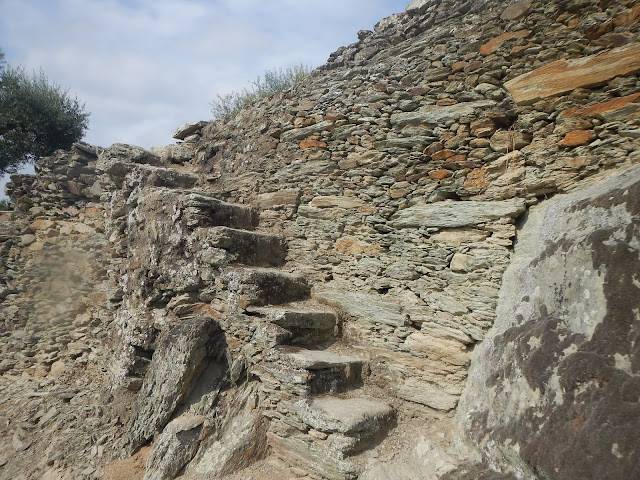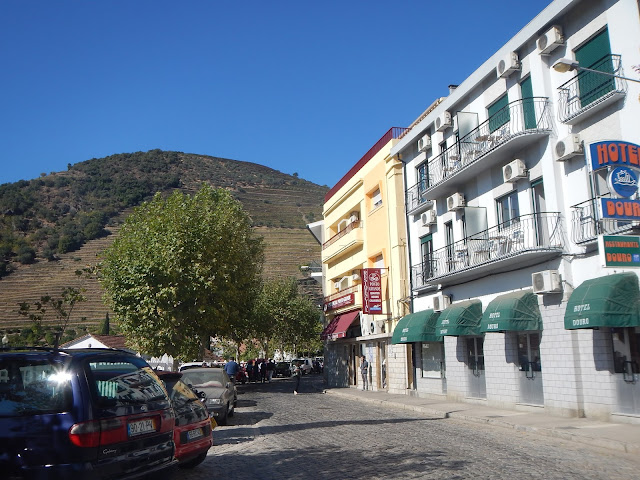We awoke early and rolled our packed bags the 4 blocks to the Sao Bento Train Station with time to spare. The interior of the Sao Bento Train Station is superb. We were able to marvel at the astounding artistic craftsmanship on the interior tiles.
When one enters the Sao Bento Train Station, the sight of the 20,000 floor to ceiling blue and white handpainted tiles is breathtaking. Considering they are now a century old, these stunning tiles have withstood the test of time superbly.
The 20,000 tiles are traditional "azulejos", or Portuguese tiles. It took Jorge Colaco, the most renowned tile painter in Portugal, 11 years, from 1905-1916 to create, hand-paint and lay the 20,000 tiles.
These exquisite tiles depict a series of scenes from Porto's past everyday life and important historical events most notably the marriage of King John 1 and Queen Philippa of Lancaster standing by the cathedral in 1387;
and their son Prince Henry the Navigator conquering Ceuta in Morocco.
Waiting for our "regional" train to the Douro River valley, I had a strong sense that I had seen this train station and some of the commuters before; and indeed I had...watching Harry Potter movies.

We were told that J. K. Rowling had lived in Porto, and as her story goes, while living here, she left an unhappy marriage, divorced and wrote literature at a Porto's cafe. It is said that much of the Harry Potter series was inspired by, and parts based on, what she saw here in Porto from the university's uniform to the San Bento train station.



The photo above is of the train station from the Harry Potter films.
The photo below is of our train in the Sao Bento Train Station.

The train arrived right on time, albeit without any Hogwarts' students. It was another beautiful, sunny, cloudless day.
The weather provided gorgeous views of the region as we enjoyed our two and a half hour train trip from Porto to our destination of the small town of Pinhao, located in the heart of the Douro River valley.
The Douro River valley has a fascinating history. In the 17th century, British traders developed a taste for wines from the Douro region. It proved difficult to maintain the quality of the wine during the long sea voyage to England. Quite by accident, two brothers discovered that fortifying the wines with brandy preserved their quality. The wine also picked up the flavor of the oak barrels in which it was shipped. The English grew to like the fortified taste and oaky flavor, and an industry of port wine was born. So while Jamestown was being settled in 1607 and the Pilgrims were starving throughout their first winter in 1620, the British were feeling warm in England drinking their bottles of Douro River valley port.
The heart of the port wine growing region is the stretch of the Douro River near the tiny town of Pinhao, and that would be our destination for the next 4 days and 3 nights.
We arrived to glorious sunshine in the tiny, quaint Pinhao train station located near the Douro River's edge.


The Pinhao Train Station had some lovely hand painted tiles on the exterior of its small facade.

which illustrated the history of this grape growing region.



Our cab ride from the Pinhao train station up the steep, serpentine, no guardrailing, narrow road that wound its way around perilous turns over steep drop-offs as it flew up to the mountain top was rather daunting. But, once at the top, the white-knuckled ride was well worth it!
We opted to stay in a casa high above Pinhao, in the tiny hamlet of Casal de Loivos, which heralds perhaps the most dramatic view in this region.
Our lodging was a 17th century mansion, Casa Casal de Loivos,
that was converted into a six room hotel with lovely antique furnishings and tall French bedroom doors leading outside to
this spectacular view!


And, as if the view wasn't wonderful enough, Casa Casal de Loivos, came complete with a pool shown below,

(and that's just the pool house in this photo. The Casa is on the the upper level). The pool is located on the lower level in front of the vineyards, which I might add, are working vineyards and they produce divine port wine which is only for the owners, the warm Sampayo family, and their few guests. Lucky me! Cheers!

Port wine can technically be grown only in the Douro valley. This valley has a micro-climate that is conducive to growing grapes: hot and dry in the summer, with extreme rainfall and cold in the winter. The geology is such that the grapes send their tap root deep into the ground (30 feet) to access the water table. The Douro River's steep, twisting canyons have been laboriously terraced by centuries of farmers for production of grapes, almonds, and olive trees. Quintas are farms that produce port and table wines for commercial use.

We toured Quintas and sampled the region's glorious port wine. We had selected a smaller, independent Quinta to tour that was recommended as less commercialized, thus providing us a more personalized experience where we were offered the chance to meet the people

who have devoted their lives to making the best wines available. There was a huge sense of pride in making this wine and the taste proved their hard work and efforts had paid off.

One of the nicest aspects of this Quinta was the self-guided audio tour thru its vast vineyards. This self-guided audio was filled with the history of vineyards and winemaking. For us, this was the best type of tour for it allowed us to turn off the audio at will and linger to take photos of the beautiful vistas.


Throughout our time in the Douro Valley, we saw terraced vineyards, which look like vibrant green ribbons, line the undulating countryside's steep rocky slopes. These terraces are everywhere, as far as the eye can see.

It is absolutely astounding to contemplate that for literally hundreds of years, multiple generations of vintners had painstaking moved stone after stone

to create these terraced vineyards.

These terraces (called geios) give he Douro Valley a very dramatic look.

This portion of the Douro provides the incredible visual effect of endless sculptured rows of terraces in the harsh, arid terrain;

and yet, incredibly, this environment produces such a delectable, favorable elixir. "Over the years, vintners have learned to micromanage their grapes, fine-tuning specific qualities to get the very best port for their conditions".
Building and maintaining these terraces is expensive and the grapes planted there must be cultivated by hand

along with cutting each bunch of grapes by hand for the harvest.
Lately, some larger companies have started using bulldozers(!) to create large terraces called patamares, that can be worked on by machines.
This produces fewer plants per parcel. Purists are not amused by these technological modern advances.

To make the finest port, many Quintas, such as the one we visited in the Douro still, believe it or not, still stomp grapes by foot- not because "of quaint traditions; but because it's the best way. Machines would break the grapes' seeds and stems, releasing a bitter flavor-but soft soles of the feet don't. During harvest time, (which we just missed , it's late September -early October), the grapes are poured into big granite tubs called laggards. A team of two dozen stoppers line up across from each other, put their arms on each other's shoulders, and march, military style, to crush the grapes. This stomping can last three or four days, and generally dissolves into a party atmosphere. The Quinta we visited shows exactly that merry atmosphere of stomping grapes for 4 days.

This is one of my favorite photos of our trip in Pinhao. I especially love the accordion player in the middle!
Here's the actual vat from the photo above that is still used today. It's pretty deep.
The wine is then stored in barrels




"Port traditionally stays in the Douro Valley for one winter after it is made, as the cold temperatures encourage the wine and brandy to marry. Then it is taken to Porto, where the more humid, mild climate is ideal for aging. For centuries port wine could technically be aged, marketed, and sold in Porto. But this was deregulated in 1987; now any Douro Quinta that offers tours can sell its port directly to visitors".
Along with grapes, many terraces have olive tree groves. We visited an olive oil maker who showed his antique methods of generating olive oil. Throughout the day we developed a greater application of the multiple layers of labor and techniques that were, and many still are, involved in making virgin and extra virgin olive oil.

Each day was filled with exploring this stunning area with its spectacular views. The temperature remained a lovely 84 degrees with blue skies throughout each day. The reflection of the aquaduct and boats on the Douro were lovely to look at each day as we wandered through the little town of Pinhoa.
Pinhao is a popular stop for the Viking river cruise boats and other river cruises as well.
The view depicted on the tile from the exterior of the Pinhao train station looks the same a century later.

This is the "bustling" main street of Pinhao.

Lots of palm trees lining the streets.
Since we had taken the train up the Douro River valley to Pinaoh, we decided to take a small riverboat back to Porto. There were only 50 passengers aboard this spacious boat. Our Douro River cruise was 7 hours along this scenic route. From the water we were able to see the train we had taken 4 days ago as we had been headed to Pinhao.
On board the boat, we were served a lovely lunch. Everyone had reserved seating and our table for two came complete with white linen tablecloth, a vase of fresh roses and a bottle of wine. It was a lovely way to end our trip to the scenic Douro River valley.











